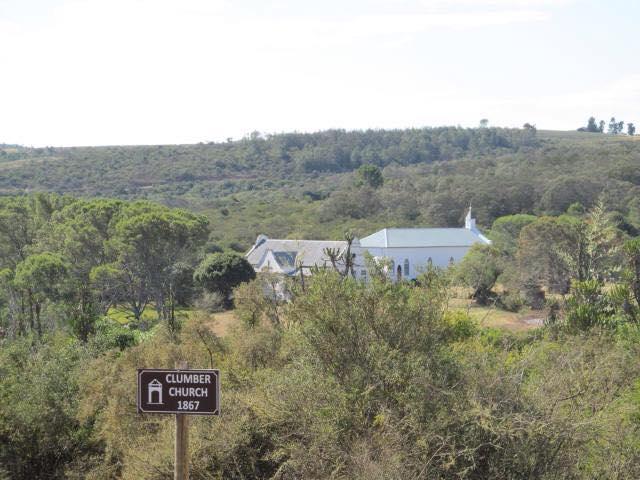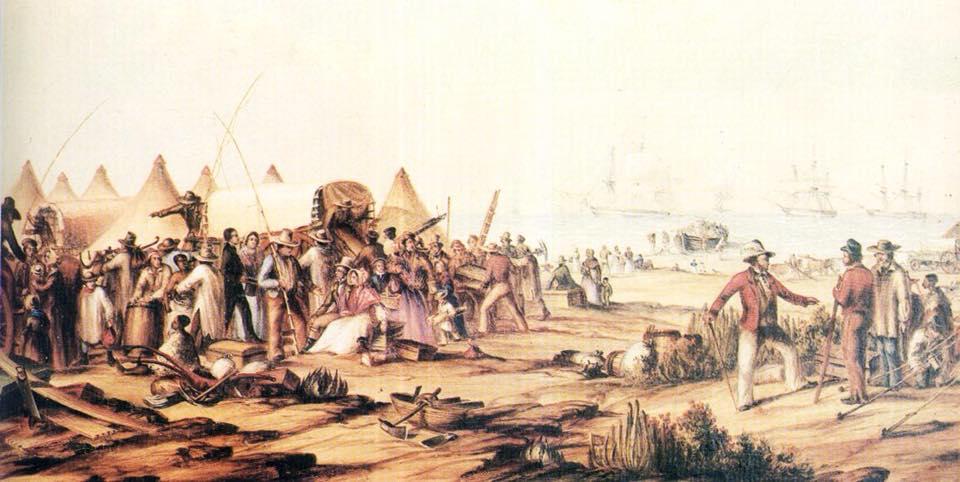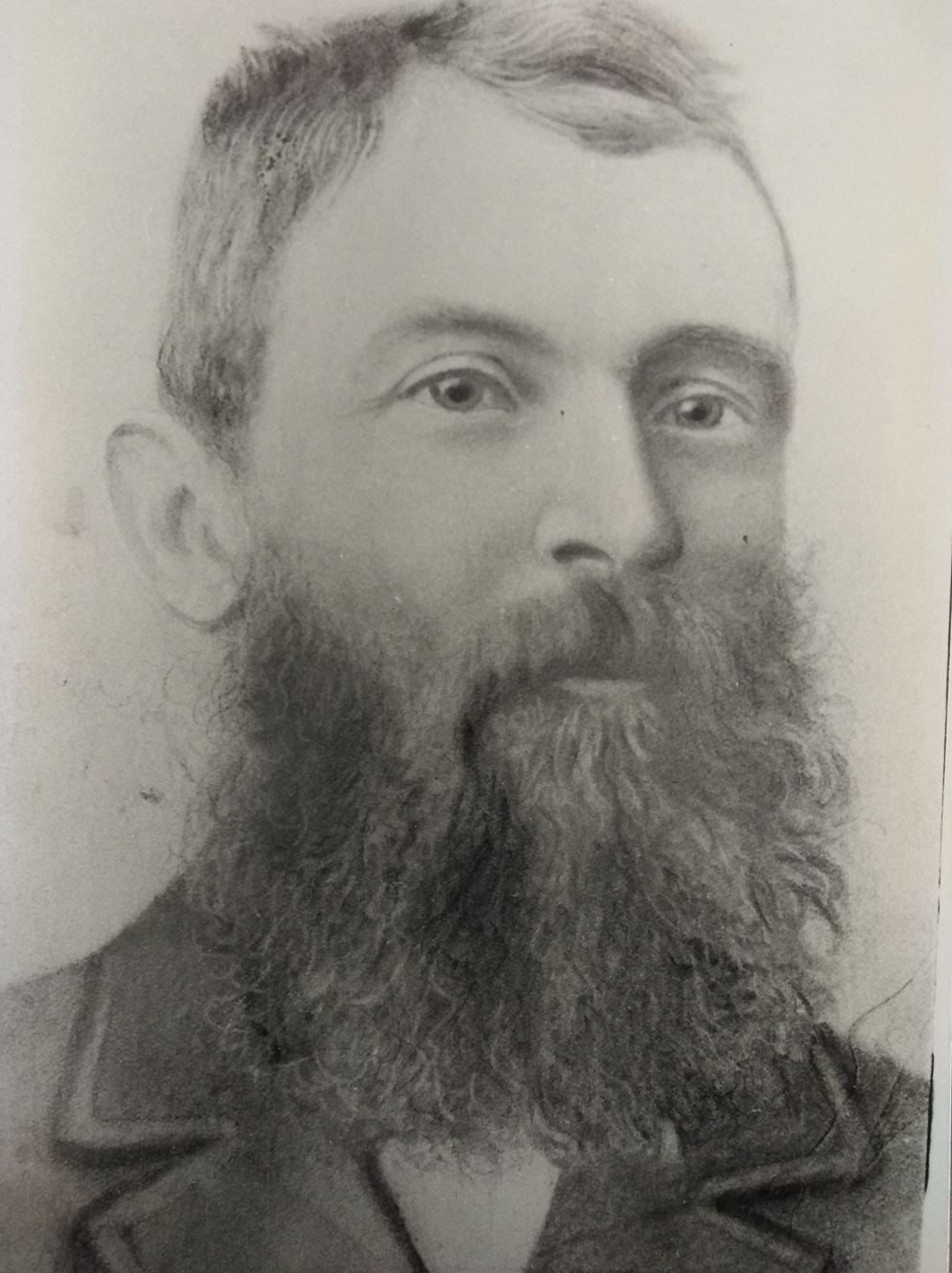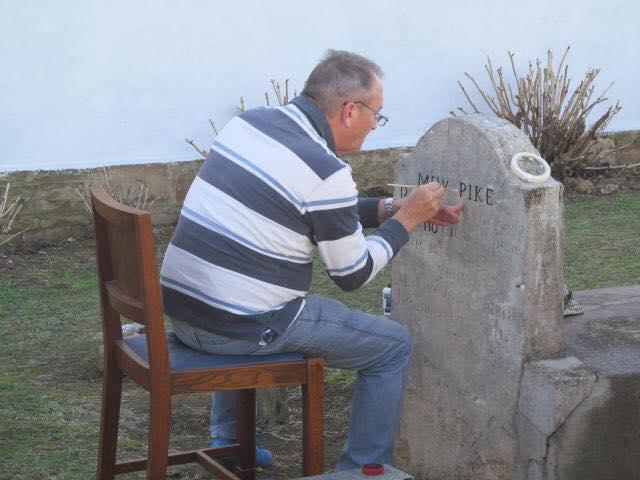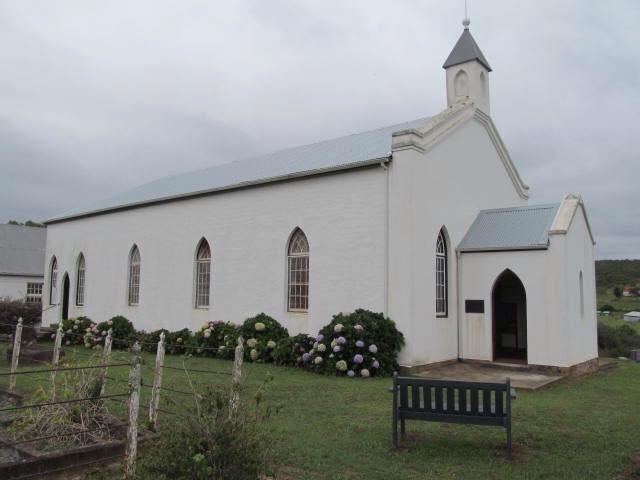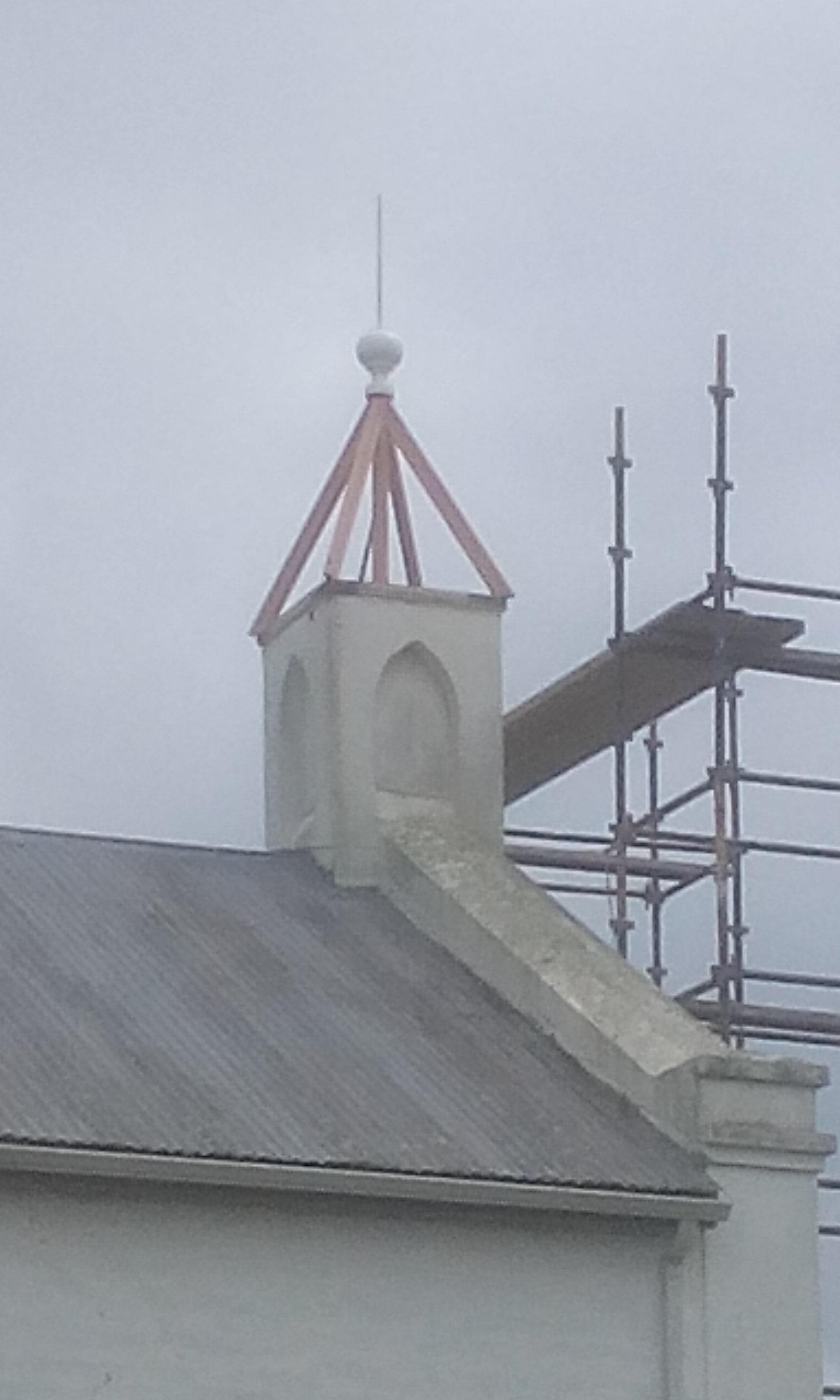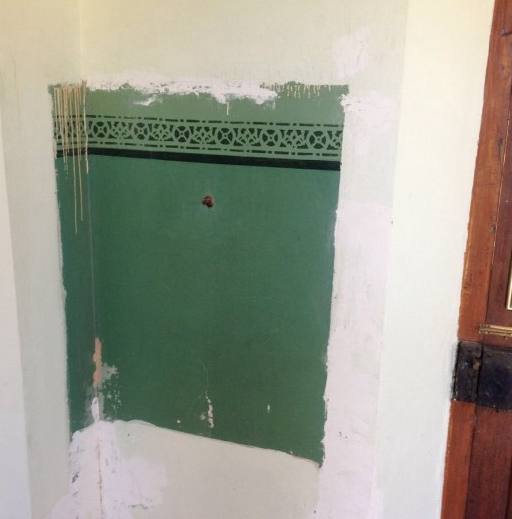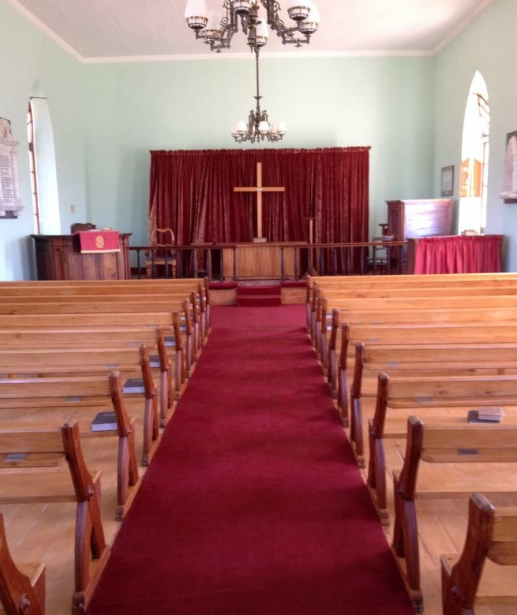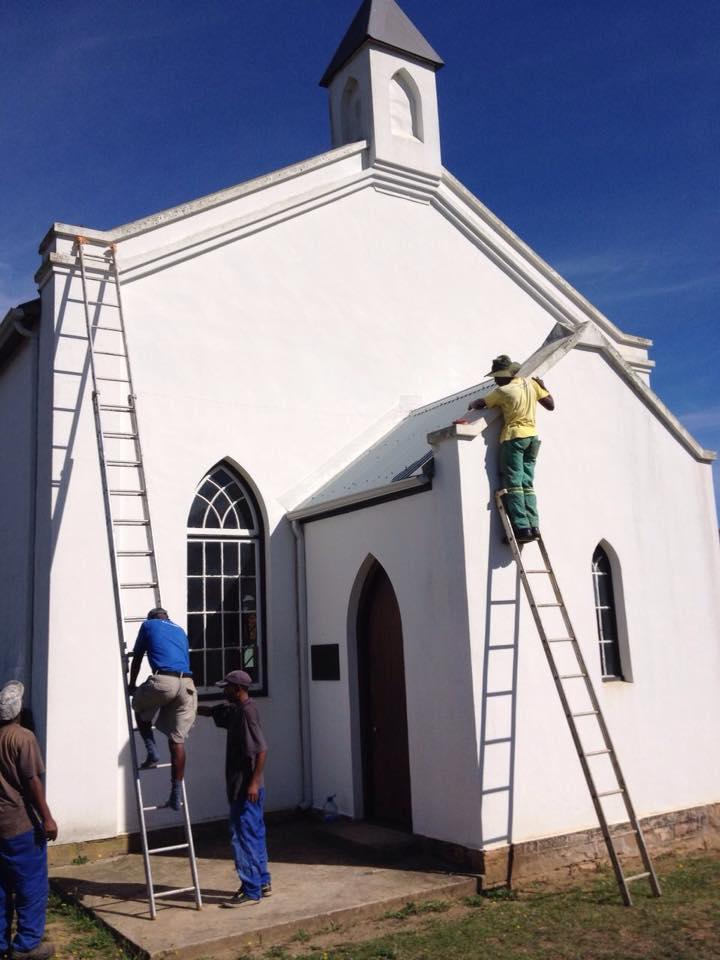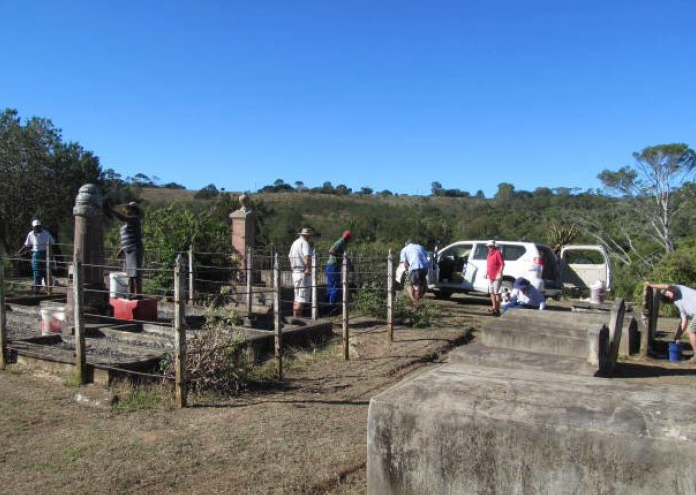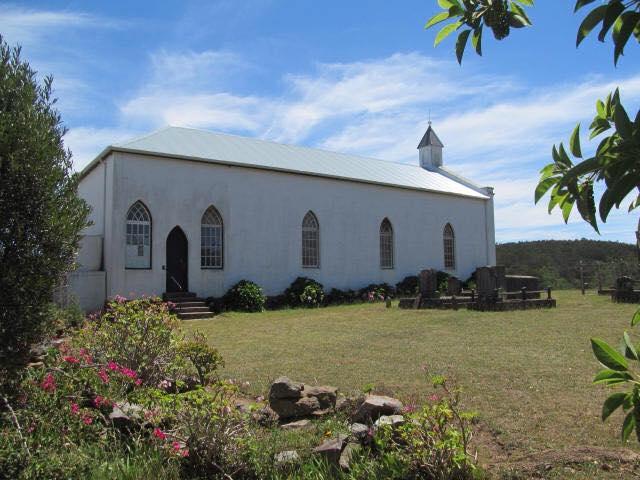
Disclaimer: Any views expressed by individuals and organisations are their own and do not in any way represent the views of The Heritage Portal. If you find any mistakes or historical inaccuracies, please contact the editor.
In the vale of Clumber in the Eastern Cape, 5 km from Bathurst just off the Shaw Park road, lies Clumber Church. Situated on a knoll, this is the third Church to be built on this spot by the Nottingham Party and descendants of the 1820 Settlers. This knoll was given the name of Mount Mercy by the Nottingham Party in thanksgiving for their safe arrival here on a journey which had taken them over 6 months to complete. The wagons and carts that had transported them from "Tent Town" on the dunes of Algoa Bay to their final destination were offloaded at the base of Mount Mercy close to the Torrens River. A Service of Thanksgiving was held on Mount Mercy on the day of their arrival on July 23 1820.
Clumber Church from a distance
The Nottingham Party was one of the few Parties of 1820 Settlers that consisted of the poor as Nottingham was a cottage industry hub of lace and hosiery making. With the Industrial Revolution under way most of these family run cottage industries had to shut down. It was also the end of the Napoleonic Wars so demand for goods had slackened off and soldiers had returned from war with no prospect of employment. It was a time of massive unemployment with thousands starving.
The prospect therefore of the promise of a piece of land in a foreign country looked appealing and hundreds applied. As the applicants could not even afford the passage, the Duke of Newcastle agreed to garner financial support and raised sufficient funds to allow 167 persons to emigrate. From records we are able to determine that the departure was rather hurried. John Bradfield's application was dated October and by mid January the family was aboard the Albury in Liverpool. The Party gathered in Nottingham from where the men walked over the Pennine Moors under Sergeant Dennison to Liverpool whilst the woman and children travelled by coach and cart. By January 17 they were aboard the Albury as they were trying to reconcile the records of those who had applied versus those who were allready aboard. It was bitterly cold in England with vessels on the Thames unable to move from being iced in. The plans to depart before the end of January were thwarted by a cold front which had swept in and delayed departure till February 13. The Albury struck severe weather off the coast of Wales and the hatches had to be battened down much to the consternation of those below. Conditions were cramped with married couples lying 4 and even 6 to a bed. The single men were given a blanket and had to lie where they could on the bare boards.
On 1 May 1820 the Albury arrived in Simons Town but the Settlers were not able to disembark. Their cramped conditions were made even worse when three parties from the vessel Zoroaster numbering 142 persons joined the Albury on their last leg to Algoa Bay. They arrived here on 15 May together with vessel Aurora carrying 344 persons, vessel Brilliant carrying 144 and Weymouth carrying 478. Here they had to ride at anchor and await their turn to be pulled to shore. Once disembarked they were housed in tents on the sea shore awaiting their turn for the ox wagons and carts to take them onto their final destination.Some 2000 tents provided accommodation for this massive influx of people. The Nottingham Party waited here for 48 days before finally leaving on 15 July 1820.
Settlers camped at Algoa Bay
The convoy of wagons used the coastal route from Addo Heights passing Congo's Kraal and Graafwater to Jagers Drift on the Bushmans River. After Theopolis Mission Station they forded the Kowie River near the mouth and turned inland to Bathurst and to their final destination which they named Clumber after the seat of the Duke of Newcastle, Clumber Park.
The head of the Nottingham Party, Dr Calton, died in Algoa Bay. His successor, Thomas Draper, left Clumber not long after arrival, so the leadership passed to William Pike a Methodist, who administered spiritual comfort from the moment the Party boarded the Albury.
William Pike 1820 Settler and final Leader of the Nottingham Party
Prior to the first Church being built, the Nottingham Party used to congregate under the trees at John Bradfield's home, in inclement weather at William Pike's and even in the open on Mount Mercy. The first Service conducted by an ordained minister was on January 11 1821 when Rev William Shaw visited Clumber. By April 1821 a district preaching plan had been put into operation which resulted in a Service being held each Sunday.
The first 100 Seater Church was opened on September 28 1825 at Mount Mercy which was remarkable considering the financial circumstances of the Party and that there were three successive crop failures due to rust and the Great Flood of October 1823.
William Pike died in 1829 and is buried close to the existing Church. In 1834 the 6th Frontier War erupted and the entire district had to be vacated and thus lay abandoned. The Settlers concentrated in Bathurst but the authorities deemed the protection here insufficient so on December 28 they were relocated to Grahamstown under armed guard. The first Clumber Church was entered during this time and when everyone returned it was recommended that a second, 200 Seater Church be built. By 1837 this second Church was operational. Rev John Ayliff , a friend of Clumber for twenty years past, preached in January 1845.
Neill Pike re-lettering William Pike's headstone. William became the leader of the Nottingham Party at Clumber and was a local preacher
In March 1846 the Seventh Frontier War, or War of the Axe began. In April the Clumber Church became the Clumber Command Station with Thomas Cockroft as Commandant. Rather than evacuating the entire area, the Church became the refuge for women and children whilst the men were on reconnaissance duties. Martial law was lifted in January 1847 but it was not possible to resume Services until March.
On December 27 1850 the Eighth Frontier War began and during this time the base camp was established on Edward Timm's farm, Prospect, as it was easier to defend than the Church. By January 1851 most Clumber people were in the camp, living in wagons and hastily erected wattle and daub huts. Hostilities only ended in March 1853. The Church badly needed repairs and Thomas Tarr and William Foxcroft were each paid 10/- for the work.
In August 1854 William Shaw preached the Anniversary Sermon, over 33 years since his first visit.
With the congregation increasing, and the Church being in a poor state, the erection of a new Clumber Church had to be considered. In July 1860 with Purdon Smailes in the Chair it was passed that a Church of 45 feet by 20 feet should be built.
In July 1866 it was decided to incorporate a ten foot by six foot porch as well as a steeple. On July 11 1866 George Wood MLC laid the foundation stone. Plans and specifications were done by George Jarvis, a draughtsman from Port Alfred.. The church was to have three Windows on each side and stone walls of 14 feet high. This height was increased to 16 feet in September 1866. Brislin and Mack tendered £162-15-0 for the masonry, plastering and materials and an extra £2-5-0 for the increased wall heights. Charles Poulton tendered £90 including materials, for carpentry of the roof, floor, ceiling doors and windows. In November1866 he also tendered 2s/6d each for the making of the yellowwood pews. In June 1916 a Vestry was was added at a cost of £320.
Opened in November 1867, the Church and School were proclaimed National Monuments on 23 November 1980. The South African Heritage Resource Agency has granted the Clumber precinct Heritage Status. SAHRA Identifier Number 9/2/009/0014.
Clumber Church
In December 2015 it was seen that the Steeple was literally falling apart. Swarms of bees inhabited the space and this rotted the supporting central sneezewood pillar. Ian Rudman, a master craftsman from Port Alfred undertook the disassembling of the structure and a rework of the sneezewood orb. He reassembled the entire structure in January 2016.
Steeple Replacement
In July and August 2016 there was great concern as the roof was leaking badly. The Yellowood floors and pews were being damaged, the walls were streaked and damp and our 1902 Harmonium and Gors and Kallmann piano, also from 1902, were under threat from the damp conditions.
As the congregation is small and quite unable to cope financially with the costs of repairs, we decided to try social media in an attempt to raise funds. A website was published (click here to view) together with two Facebook pages, one to update progress on the repairs and the other to reflect happenings at the Church. In September we stepped out in faith with no funds in our Restoration Account and ordered the material for the roof - R65000 was needed for this project. At completion that amount had been donated. We then repaired our harmonium and piano, at a cost of R15000. Again, we did not have the funds when we commissioned the repairs, but on completion of the work, precisely one day later, we had the funds available. Miracles. To celebrate, we held a Carols by Candlelight Service in early December, the first in living memory.
In January 2017 we commenced with the repainting of the interior and the repairs to the Yellowwood floors and the Yellowwood Pews. A section of wall was uncovered which showed an earlier darker green had been used in the past together with a stencilled pattern. This area has been retained. The floors and pews were sanded and sealed and are now looking magnificent.
The Darker Green Stencilled Pattern
Interior Restoration
Once the interior was completed, we then repainted the exterior. Simultaneously our farmers started clearing the Common of invasive bush as well as alien vegetation. This was concluded in July when we called in a contractor to assist in this huge task.
Repainting the exterior
In April we convened a work party to scrub and clean the gravestones and regravelling where necessary. In July a second work party almost completed our objective of cleaning approximately 200 graves.
Cleaning the Churchyard
Our funding appeals have resulted in the Church being totally restored, ready to serve many future generations! And to celebrate the completion of the repair and restoration tasks we are embarking on an ambitious 150th Anniversary Celebrations on October 20, 21 & 22. Click here for all the details.
About the author: Courteney George Bradfield attended Clumber Church. Clumber Sunday School and Clumber School in his youth. He is a descendant of Granville Glasson Bradfield, father, Edmund George Bradfield, grandfather, Jonathan Bradfield, Great Grandfather, Joseph Bradfield, GG Grandfather and John Bradfield GGG Grandfather, all buried at Clumber. He is responsible for the Clumber Church website and Chairman of the Church Committee.
Comments will load below. If for any reason none appear click here for some troubleshooting tips. If you would like to post a comment and need instructions click here.

